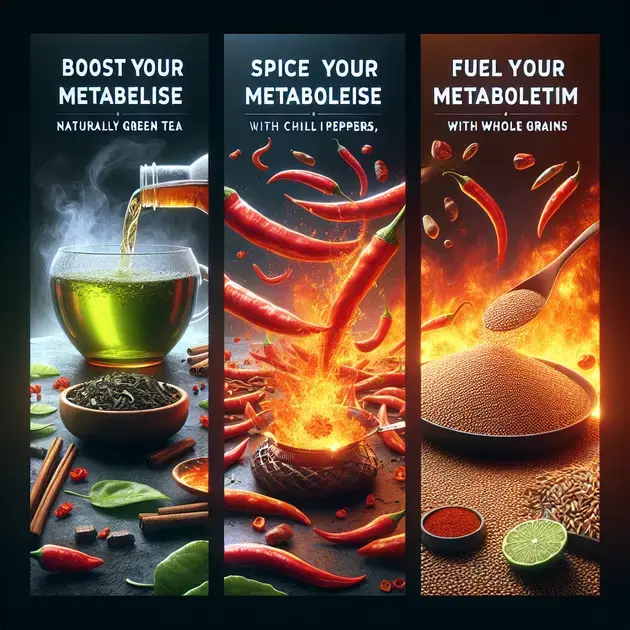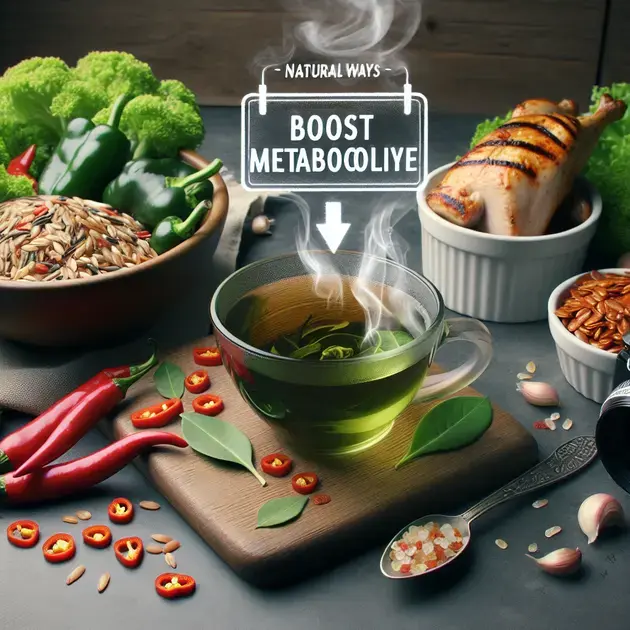
Are you looking to boost your metabolism and enhance your overall health? One effective way to achieve this is by incorporating metabolism-boosting foods into your daily diet. These foods contain specific nutrients and compounds that can help increase your metabolic rate, leading to improved energy levels and potential weight loss.
Studies have shown that certain foods such as green tea, chili peppers, and whole grains have thermogenic properties that can temporarily raise your metabolism after consumption. By including these metabolism-boosting foods in your meals, you can support your body in burning calories more efficiently throughout the day.

Boost Your Metabolism Naturally with Green Tea
Green tea is a natural metabolism booster that can help you burn more calories throughout the day. The key component in green tea that promotes this effect is catechins, a type of antioxidant that is known to increase metabolism. To benefit from green tea’s metabolism-boosting properties, try to drink at least 2-3 cups daily.
To incorporate green tea into your routine, you can start by selecting a high-quality green tea product. Brands like Twinings or Lipton offer a variety of green tea options that are easily accessible in most supermarkets. You can also explore online retailers like Amazon or Thrive Market for a wider selection.
To prepare a cup of green tea, simply boil water and steep your green tea bag for 2-3 minutes. You can customize your tea by adding honey or lemon for extra flavor. For a convenient way to track your daily green tea intake and set reminders, you can use the mobile app “MyTea” available for both Android and iOS.
In addition to boosting metabolism, green tea offers numerous health benefits, such as improving brain function and reducing the risk of certain diseases. By making green tea a part of your daily routine, you can support your overall health and wellness.
Spice Up Your Metabolism with Chili Peppers
Chili peppers contain a compound called capsaicin, which is known for its metabolism-boosting properties. Capsaicin can increase the number of calories your body burns and may also reduce appetite, making it a great addition to your weight management plan. To spice up your metabolism with chili peppers, consider adding them to your meals on a regular basis.
You can purchase fresh chili peppers from your local grocery store or farmer’s market. Alternatively, you can explore online spice shops like Penzeys Spices or Spice Jungle for a wider selection of chili pepper varieties. Experiment with different types of chili peppers, such as jalapeños, habaneros, or cayenne, to find the level of spiciness that suits your taste.
To incorporate chili peppers into your diet, try adding them to soups, stir-fries, or salsas for an extra kick of flavor. You can also create homemade hot sauces or chili oils using chili peppers for a customizable spice experience. To discover new recipes featuring chili peppers and track your daily intake, check out the cooking app “SpicyPal” available for download on both Android and iOS devices.
Remember to start with small amounts of chili peppers if you are not used to spicy foods and gradually increase the quantity as you build tolerance. By including chili peppers in your meals regularly, you can boost your metabolism and add exciting flavors to your culinary repertoire.
Fuel Your Metabolism with Whole Grains
Whole grains are a valuable source of complex carbohydrates, fiber, and essential nutrients that can support a healthy metabolism. Unlike refined grains, whole grains are minimally processed and retain their natural fiber and nutrients, making them a nutritious choice for fueling your body. To optimize your metabolism with whole grains, aim to incorporate them into your daily meals.
You can find a variety of whole grain options at your local supermarket, including quinoa, brown rice, whole wheat pasta, and oats. Look for products labeled as “100% whole grain” or “whole wheat” to ensure you are getting the full nutritional benefits. Online grocery platforms like Thrive Market or Walmart Grocery also offer a diverse selection of whole grain products for convenient home delivery.
To fuel your metabolism with whole grains, try replacing refined grains with whole grain alternatives in recipes such as salads, soups, or grain bowls. You can also enjoy whole grain bread, crackers, or cereals as part of a balanced breakfast or snack. For meal planning and recipe ideas featuring whole grains, explore the “Whole Grains Council” website, which provides a wealth of information on different types of whole grains and their health benefits.
By making whole grains a staple in your diet, you can support a healthy metabolism, improve digestion, and maintain energy levels throughout the day. Start exploring the diverse world of whole grains and enjoy the nutritional benefits they have to offer.

**Revving Up Your Metabolism with Lean Protein**
Protein Importance for Metabolism
Protein is an essential macronutrient that plays a crucial role in revving up your metabolism. It requires more energy to digest protein compared to fats and carbs, leading to a higher calorie burn during digestion, also known as the thermic effect of food. By including lean protein sources such as skinless chicken, turkey, fish, tofu, and legumes in your diet, you can increase your metabolism and support weight management.
Incorporating Lean Protein into Your Meals
To maximize the benefits of lean protein for your metabolism, aim to include a source of protein in every meal and snack. Start your day with a breakfast rich in protein, such as eggs or Greek yogurt. For lunch and dinner, include grilled chicken, fish, or lentils as your main protein source. Snack on protein-rich foods like almonds, cottage cheese, or edamame throughout the day to keep your metabolism running efficiently.
Meal Prepping with Lean Protein
One effective way to ensure you get an adequate amount of lean protein in your diet is by meal prepping. Cook a batch of lean protein sources at the beginning of the week, such as grilled chicken or turkey meatballs, and portion them out for your meals ahead of time. This not only saves you time during the week but also helps you stick to your healthy eating plan and boost your metabolism.
Tracking Your Protein Intake
To optimize your metabolism with lean protein, it’s important to track your daily intake and ensure you’re getting enough protein for your body’s needs. Use food tracking apps or journals to monitor your protein intake and make adjustments as needed. Consulting a nutritionist or dietitian can also help you determine the right amount of protein for your metabolism and overall health goals.
Benefits of Lean Protein for Muscle Mass
In addition to supporting metabolism, lean protein is essential for maintaining and building muscle mass. As muscle tissue requires more energy to maintain than fat, increasing your lean protein intake can help you achieve a toned and lean physique. Combined with regular exercise, lean protein can enhance your metabolism and promote overall wellness.
**
Conclusion
**
Protein plays a vital role in boosting metabolism due to its higher thermic effect, requiring more energy to digest compared to fats and carbs. By incorporating lean protein sources like skinless chicken, turkey, fish, tofu, and legumes into your diet, you can support weight management and increase calorie burn during digestion.
Including lean protein in every meal and snack
To maximize the benefits of lean protein for your metabolism, make it a priority to include a protein source in all your meals and snacks. Starting your day with a protein-rich breakfast and incorporating grilled chicken, fish, or lentils into your lunch and dinner can help keep your metabolism running efficiently throughout the day.
Meal prepping and tracking protein intake
Prepare lean protein sources in advance through meal prepping to ensure you meet your daily protein requirements. By portioning out foods like grilled chicken or turkey meatballs, not only do you save time but you also stick to healthy eating habits and boost metabolism. Additionally, tracking your protein intake using apps or journals can help you adjust accordingly and reach your health goals effectively.
Lean protein benefits for muscle mass and overall wellness
Beyond metabolism, lean protein plays a crucial role in maintaining and building muscle mass. As muscle tissue requires more energy for upkeep, increasing lean protein intake can aid in achieving a toned physique. When combined with regular exercise, lean protein not only promotes metabolism but also enhances overall wellness. Ensure a balanced diet rich in lean protein to reap the benefits for your health and fitness journey.